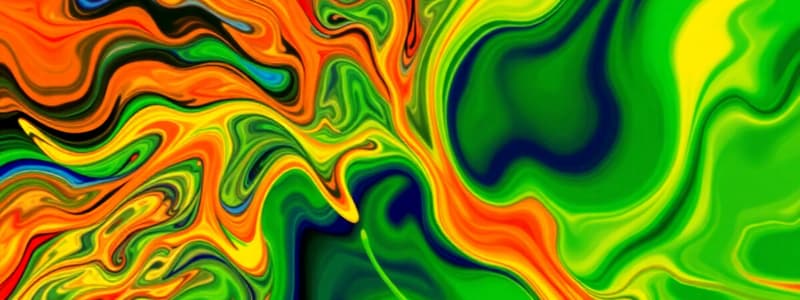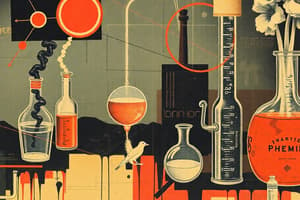Podcast
Questions and Answers
Which of the following best describes thermochemistry?
Which of the following best describes thermochemistry?
- The study of nuclear reactions and radioactive decay.
- The study of the relationships between chemical reactions and energy changes involving heat. (correct)
- The study of the motion of objects at high speeds.
- The study of the properties of matter at absolute zero.
A bicyclist is coasting on a flat road and begins to go up a hill without pedaling. What happens to the bicyclist's kinetic and potential energy?
A bicyclist is coasting on a flat road and begins to go up a hill without pedaling. What happens to the bicyclist's kinetic and potential energy?
- Kinetic energy increases, potential energy decreases.
- Kinetic energy decreases, potential energy increases. (correct)
- Both kinetic and potential energy decrease.
- Both kinetic and potential energy increase.
Which of the following is the correct formula for kinetic energy?
Which of the following is the correct formula for kinetic energy?
- $E_k = mv$
- $E_k = \frac{1}{2}mv$
- $E_k = mv^2$
- $E_k = \frac{1}{2}mv^2$ (correct)
Electrostatic potential energy between two charged particles is affected by which of the following factors?
Electrostatic potential energy between two charged particles is affected by which of the following factors?
According to the formula for electrostatic potential energy, what happens to the energy ($E_{el}$) as the distance (d) between two oppositely charged particles increases?
According to the formula for electrostatic potential energy, what happens to the energy ($E_{el}$) as the distance (d) between two oppositely charged particles increases?
What is the process that converts chemical energy to thermal energy?
What is the process that converts chemical energy to thermal energy?
Which unit is equivalent to the SI unit of energy, the joule (J)?
Which unit is equivalent to the SI unit of energy, the joule (J)?
If 1 calorie is exactly 4.184 J, how many joules are in a nutritional Calorie (1 Cal)?
If 1 calorie is exactly 4.184 J, how many joules are in a nutritional Calorie (1 Cal)?
In a chemical reaction within a flask, what constitutes the 'system' according to thermodynamics?
In a chemical reaction within a flask, what constitutes the 'system' according to thermodynamics?
A student performs a reaction in an open beaker. Identify the type of system present.
A student performs a reaction in an open beaker. Identify the type of system present.
Consider a reaction occurring within a closed cylinder fitted with a piston. Energy can be exchanged with the surroundings as heat or work, but matter cannot enter or leave. What type of system is this?
Consider a reaction occurring within a closed cylinder fitted with a piston. Energy can be exchanged with the surroundings as heat or work, but matter cannot enter or leave. What type of system is this?
A perfectly sealed, insulated container prevents any exchange of heat or matter with its surroundings. What kind of system is this?
A perfectly sealed, insulated container prevents any exchange of heat or matter with its surroundings. What kind of system is this?
A scientist studies a reaction in a bomb calorimeter, a closed system, and observes a significant temperature increase. What can be concluded about the reaction?
A scientist studies a reaction in a bomb calorimeter, a closed system, and observes a significant temperature increase. What can be concluded about the reaction?
In thermodynamics, what distinguishes an 'open system' from a 'closed system'?
In thermodynamics, what distinguishes an 'open system' from a 'closed system'?
Concerning human beings, which type of thermodynamic system, is most accurate?
Concerning human beings, which type of thermodynamic system, is most accurate?
What is the definition of 'work' in the context of energy transfer?
What is the definition of 'work' in the context of energy transfer?
How is 'heat' defined in thermochemistry?
How is 'heat' defined in thermochemistry?
Using the formula $w = F \times d$, if a force of 50 N is applied to move an object 10 meters, how much work is done?
Using the formula $w = F \times d$, if a force of 50 N is applied to move an object 10 meters, how much work is done?
A bowler lifts a 5.4-kg bowling ball from the ground to a height of 1.6 m. Assuming the work done to raise the ball is converted to potential energy, what happens to the ball's potential energy as it is raised?
A bowler lifts a 5.4-kg bowling ball from the ground to a height of 1.6 m. Assuming the work done to raise the ball is converted to potential energy, what happens to the ball's potential energy as it is raised?
Three objects move at different speeds. Object A (500-kg) moves at 100 km/h, Object B (1,000-kg) moves at 50 km/h and Object C (1,500 kg) moves at 30 km/h. Which object has the greatest kinetic energy?
Three objects move at different speeds. Object A (500-kg) moves at 100 km/h, Object B (1,000-kg) moves at 50 km/h and Object C (1,500 kg) moves at 30 km/h. Which object has the greatest kinetic energy?
What determines whether a system is classified as open, closed, or isolated?
What determines whether a system is classified as open, closed, or isolated?
Why is a boiling pot of water on a stove considered an open system?
Why is a boiling pot of water on a stove considered an open system?
Which of the following best describes an isolated system?
Which of the following best describes an isolated system?
What is the primary difference between kinetic and potential energy?
What is the primary difference between kinetic and potential energy?
What happens to the electrostatic potential energy when two positively charged particles move closer to each other?
What happens to the electrostatic potential energy when two positively charged particles move closer to each other?
How does the concept of 'work' relate to the change in potential energy of an object?
How does the concept of 'work' relate to the change in potential energy of an object?
Which statement accurately describes the relationship between heat and temperature?
Which statement accurately describes the relationship between heat and temperature?
Which of the following is essential to classify a thermodynamic system as 'isolated'?
Which of the following is essential to classify a thermodynamic system as 'isolated'?
A chemical reaction occurs in a solution where the system absorbs heat from the surroundings. Which of the following statements is true?
A chemical reaction occurs in a solution where the system absorbs heat from the surroundings. Which of the following statements is true?
Flashcards
Thermodynamics
Thermodynamics
The study of energy and its transformations.
Thermochemistry
Thermochemistry
The branch of thermodynamics dealing with the relationships between chemical reactions and energy changes involving heat.
Energy
Energy
The capacity to do work or transfer heat.
Kinetic Energy
Kinetic Energy
Signup and view all the flashcards
Potential Energy
Potential Energy
Signup and view all the flashcards
Electrostatic Potential Energy
Electrostatic Potential Energy
Signup and view all the flashcards
Chemical Energy
Chemical Energy
Signup and view all the flashcards
Thermal Energy
Thermal Energy
Signup and view all the flashcards
Joule (J)
Joule (J)
Signup and view all the flashcards
Calorie (cal)
Calorie (cal)
Signup and view all the flashcards
System
System
Signup and view all the flashcards
Surroundings
Surroundings
Signup and view all the flashcards
Open System
Open System
Signup and view all the flashcards
Closed System
Closed System
Signup and view all the flashcards
Isolated System
Isolated System
Signup and view all the flashcards
Work
Work
Signup and view all the flashcards
Heat
Heat
Signup and view all the flashcards
Force
Force
Signup and view all the flashcards
Study Notes
- Thermodynamics is the study of energy and its transformations, stemming from the Greek words "thérme" (heat) and "dy'namis" (power).
- Thermochemistry is the area of thermodynamics concerning the relationships between chemical reactions and the energy changes, specifically those involving heat.
- Energy is the capacity to do work or transfer heat.
- Kinetic energy is the energy resulting from motion.
Potential Energy
- Potential energy is energy due to an object's position relative to other objects and can be considered stored energy.
- Electrostatic potential energy (Eel) arises from interactions between charged particles.
- Eel = kQ1Q2/d, where k is a constant (8.99 x10^9 J-m/C^2), Q represents electrical charges, and d is the distance between them.
- A coulomb (C) is the unit of electrical charge, and a joule (J) is the unit of energy.
- For charged particles at finite separation distances, Eel is positive for like charges (repulsion) and negative for opposite charges (attraction).
- As particles move farther apart, their electrostatic potential energy approaches zero.
- Chemical energy is the potential energy stored in the arrangement of atoms in a fuel.
- Thermal energy is the energy associated with temperature.
Units of Energy
- The SI unit for energy is the joule (J), named in honor of James Joule (1818-1889).
- 1 J equals 1 kgm²/s.
- Kilojoules (kJ) are often more practical due to the small size of a joule.
- A calorie (cal) was originally defined as the energy to raise 1 g of water from 14.5 to 15.5 °C.
- 1 cal = 4.184 J (exactly).
- A nutritional Calorie (C) is equal to 1000 cal or 1 kcal.
Thermodynamic Systems
- The system is the specific part of the universe under study.
- The surroundings include everything outside the system.
- In a chemical reaction, reactants and products are the system.
- The container and everything beyond it form the surroundings.
Types of Systems
- An open system exchanges both matter and energy with its surroundings.
- A closed system exchanges energy but not matter with the surroundings.
- An isolated system exchanges neither matter nor energy with its surroundings.
Work and Heat
- Work (w) occurs when energy is transferred as a force moves an object.
- A force is any push or pull exerted on an object.
- The magnitude of work is the product of the force (F) and the distance (d) over which the object moves.
- Work = F x d
- Heat is energy transferred from a hotter object to a colder one.
Studying That Suits You
Use AI to generate personalized quizzes and flashcards to suit your learning preferences.




